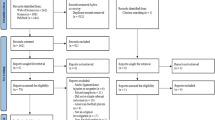Abstract
Residual impairment of knee function was tested in 25 patients 6 to 12 months after successful unilateral reconstruction of the anterior cruciate ligament. The control group comprised 25 healthy individuals. Jumping onto one foot from a height of 20 cm was taken as a prototype of similar everyday activities. We measured maximum flexion of the knee during the landing phase of the jump, and the degree of knee flexion at the time of maximum deceleration of the knee against gravity during jumping using the three-dimensional optical motion analysis system-ELITE. In the group of patients, measured parametres were significantly smaller on the operated side than on the unaffected side. These two measured values were significantly smaller on both legs in group of patients as compared to the values in the control group. The results of our study indicate that functional disturbance persisted for 6 to 12 months after anterior cruciate reconstruction. This may be due to the changed muscle activation pattern of the knee causing increased stiffness of knee muscles. It seems that re-programming of the central nervous system occurred in order to protect the injured lower extremities from another injury.
Résumé
La limitation résiduelle de la fonction du genou a été testée chez 25 malades entre 6 et 12 mois après reconstruction monolatérale réussie de ligament croisé antérieur. Le groupe témoin était composé de 25 individus sains. Le saut sur un seul pied de 20 cm de hauteur a été pris comme prototype de l’activité quotidienne. Nous avons mesuré la flexion maximale du genou pendant l’atterrissage et son degré de flexion en phase de décélération maximale par rapport à la pesanteur pendant le saut moyennant le système optique tridimensionnel d’analyse du mouvement ELITE.
Les paramètres des malades étaient significativement plus bas du côté opéré que du côté sain. Ces deux valeurs étaient significativement plus petites sur les deux jambes des patients par rapport au groupe témoin.
Les résultats de notre étude indiquent que la gène fonctionnelle persiste entre 6 et 12 mois après reconstruction du croisé antérieur, probable résultat d’une modification du modèle d’activation musculaire du genou déterminant une plus forte rigidité des muscles du genou. Il semble que le système nerveux central se re-programme pour protéger les membres inférieurs blessés contre d’autres lésions.
Similar content being viewed by others
Author information
Authors and Affiliations
Additional information
Accepted: 16 August 1999
Rights and permissions
About this article
Cite this article
Antolič, V., Straž ar, K., Pompe, B. et al. Increased muscle stiffness after anterior cruciate ligament reconstruction – memory on injury?. International Orthopaedics SICOT 23, 268–270 (1999). https://doi.org/10.1007/s002640050368
Issue Date:
DOI: https://doi.org/10.1007/s002640050368




